Navy grabs a precious maritime relic
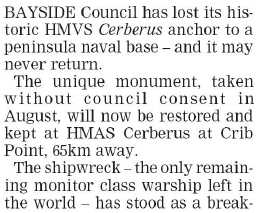 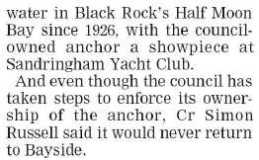 |
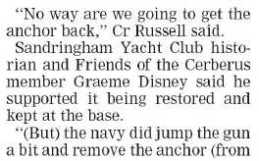 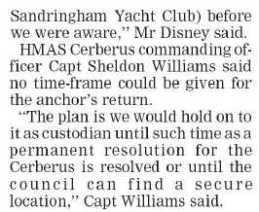 |
The Cerberus Anchors
"ANCHORS. To be supplied with 3 60-cwt bowers, 1 18-cwt stream, 1 8-cwt kedge, and 1 4-cwt kedge. The whole to be tested as usual in Her Majesty's Service." Original Specification.
A plan of the Upper Deck has the following note: -
"Note — 2 Martin's Anchors of 45 cwt each have been supplied to the ship instead of two of the Admiralty pattern, but it is not known where they will be stowed."

Soon after scuttling at Half Moon Bay one of the two martin's anchors is visible on the forecastle. This anchor was moved to the Sandringham Yacht Club in the 1960's (below). The flukes have obviously rusted as they should fall being swivelling. The anchor has since been moved to HMAS Cerberus at Flinders.


Thanks to Peter Charlesworth and Graeme Disney the second Martin's anchor may have been located. On April 6 1991 Peter Charlesworth and Jason Humphery were diving near Cerberus and discovered "a smaller admiralty type anchor" and a larger anchor. This large anchor was described as "of an unusual type being of a square shape with two flukes extending from either end and a stock extending from the centre of the square opposite and at a 90° angle of the end which contain the flukes.
As Peter recorded the location of both anchors John Toogood, ably assisted by Paradise Divers, Klipz Promotions and Three Headed Dog Productions will be organising a second relics dive to fully investigate and photograph both anchors.
From the lower deck I ascended to the flying deck, and from that elevation watched the process of weighing Martin's patent (and ponderously) anchor by the steam windlass. Slowly and surely the links keep rising out of the water, and lots of boys from the Nelson, with crooked rods of iron, fork it up, and pass it below; the hose playing upon it as it comes up, link by link, to wash off the crust of mud, with which it is coated. After thirty six fathoms have been brought up then up comes the unwieldly mud-hook, and the order is passed "easy ahead." The Herald, 28 August 1871

|
Navy grabs a precious maritime relic
|
 | Shown is a Martin's anchor on display at the Queenscliff Maritime Museum. |
We come to an anchor of entirely different shape from the preceding, patented by a Frenchman named Martin. The anchor is represented in fig. 6 in the position in which it lies on the ground just before taking hold. The shank is made in one forging, is of rectangular section, having a shoulder for the stock to fit against, and is increased both in thickness and area at the crown ; the arms with the palms are forged in one piece, and then bent to the required shape ; one of the arms is passed through a hole in the crown and is kept in position by a bolt screwed through the end of the crown, so that its point reaches a little way into an indent made for it in the round part at the back of the arms. Until very recently this securing bolt was placed in the shank in a vertical position (supposing the anchor to be lying with the palms horizontal), so as to cut into the hollow part at the part of the bent arm. A very strong shoulder is worked on the arms, so as to fit in a groove on one side of the shank, in such a manner that the arms will revolve through an angle of 30° either way. The stock is fitted over the shank as shown, and secured by a key, which fixes it tightly against the shoulder left of the shank. The advantage of Martin's anchor are as follows :It is self canting; it must fall in the position shown in the figure, and the weight of the arms, together with the pull of the cable, presses their sharp points into the soil, so that it takes hold immediately; it is impossible to foul it; it stows much more neatly than any other anchor ; its holding power is very great, as both arms are in the soil at the same time, and the stock, which is flat and broad, adds materially to this quality ; the strength is also very great. At an experiment made at Portsmouth dockyard in March 1867, two of the anchors were subjected to a strain of 50 per cent. over the Admiralty proof ; the arms were deflected but three-tenths of an inch by this great strain, and when it was removed they regained their former shape. the anchor is made in three separate forgings without a weld. Unmasted turret ships, which have all-around fire, are, almost without exception, fitted with Martin's anchor on account of the neatness with which it can be stowed, as the stock of any other anchor, if not unshipped, would obstruct the fire of the guns. The Admiralty allows a reduction of 25 per cent. in weight for Martin's anchor, using an 80 cwt. Martin where at 90 cwt. Admiralty or Rodger's anchor, weighing with its stock from 108 to 112 cwt., would be fitted, the weight given for Martin's anchor including the stock.
The above article was written by Thomas Morley, Fellow of the Institute of Naval Architects.
In 2009 the Royal Australian Navy reclaimed the Cerberus anchor and took it to HMAS Cerberus for preservation work. Shown below is the repainted anchor overlooking Hanns Inlet, HMAS Cerberus, Flinders, Victoria.
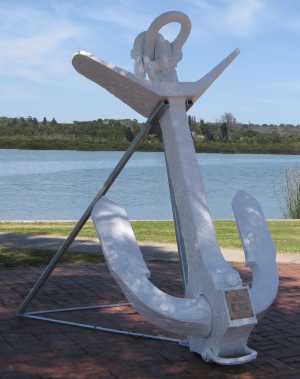

Two large anchors and a swivel from HMVS Nelson are on display in Commonwealth Reserve and Burgoyne Reserve Williamstown.
When Nelson was being moved to Sydney after her sale in 1898, the difficulty of raising the anchors was such that the chains were cut and both anchors were left at the bottom of Hobson's Bay. During dredging by the Harbour Trust in 1938 the anchors were rediscovered and dragged ashore at the end of Ann Street. Originally to be sold as scrap, successful lobbying by Captain Hartley Watson & the Vigilance Association encouraged the Harbour Trust to donate both anchors to the Association. By 1941 one anchor & swivel had been mounted in Commonwealth Reserve & at a later date the second anchor at Burgoyne Reserve.
The anchor on display in Commonwealth Reserve was forged in 1846 & it weighs 3 tons 15 cwt
The swivel, which weighs half a ton, was hand forged of Lowmoor iron & originally belonged to HMS Bellerephon (1786) which served under Horatio Nelson at the Glorious First of June and the Battles of the Nile & Trafalgar. HMS Bellerephon was the ship on which Napoleon surrendered in 1815 & was transported in to Britain. Bellerophon was being converted into a prison ship about the same time that Nelson was being fitted out which could explain how some of its fittings came to be used on Nelson. The plaque was unveiled in 1942 & incorrectly states that Bellerophone was captured from the French & gives the anchor's weight as 7 tons, most likely the weight of both anchors combined.

When Nelson was being moved to Sydney after her sale in 1898, the difficulty of raising the anchors was such that the chains were cut and both anchors were left at the bottom of Hobson's Bay. During dredging by the Harbour Trust in 1938 the anchors were rediscovered and dragged ashore at the end of Ann Street. Originally to be sold as scrap, successful lobbying by Captain Hartley Watson & the Vigilance Association encouraged the Harbour Trust to donate both anchors to the Association. By 1941 one anchor & swivel had been mounted in Commonwealth Reserve & at a later date the second anchor was erected in Burgoyne Reserve by the Williamstown Lions Club.
The anchor on display in Burgoyne Reserve weighs approximately about 3 tons.
